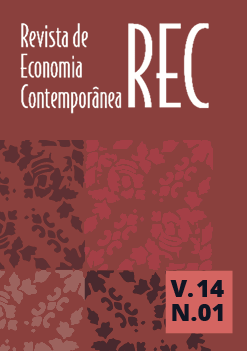A EVOLUÇÃO DAS DESIGUALDADES POR CATEGORIAS DE ESCOLARIDADE ENTRE 1996 E 2004: UMA ANÁLISE COM REGRESSÕES QUANTÍLICAS // THE EVOLUTION OF WAGE INEQUALITIES IN URBAN BRAZIL BY SCHOOLING LEVELS FOR THE PERIOD 1996 TO 2004: A QUANTILE REGRESSION APPROACH
Palavras-chave:
mercado de trabalho, diferenciais de salário, regressões quantílicas // labor market, wage differentials, quantile regressionResumo
RESUMO: Este trabalho investiga se existem modificações relevantes entre os quantis de rendimento nos retornos por escolaridade, ou seja, se os retornos por escolaridade mudaram ao longo do período para quantis diferentes, e entre estratos educacionais para os diversos quantis de rendimento (se os rendimentos relativos por quantil mudaram entre indivíduos com anos de escolaridade diversa). Foi feita análise diferenciada da evolução dessas categorias através da metodologia das regressões quantílicas nas equações de salário para um continuum de tempo, de 1996 a 2004, usando a base de dados da Pesquisa Nacional por Amostra de Domicílios (Pnad). O cenário geral dos resultados mostra que a análise quantílica por rendimento acentua a convergência entre os quantis de renda e estratos educacionais, assim como um padrão de comportamento de relativa constância para os quantis de renda mais altos. A análise vista por estratos educacionais enfatiza a queda relativa dos rendimentos do ensino fundamental e a relativa constância dos rendimentos do estrato da pós-graduação.
ABSTRACT: This study investigates if there are relevant modifications between income quantiles in returns to schooling, that is, if the schooling returns in the different income quantiles has changed, and between schooling categories in the different income quantiles (if the relative income quantile has changed in the different schooling categories). The study of these schooling categories was performed through the use of the quantile regressions approach in the wage equation for the period 1996-2004, using database drawn from Pesquisa Nacional por Amostra de Domicílios (Pnad). The big picture from the results has shown that the quantile analysis by income underlines the convergence between the income quantiles and schooling categories and also a relative steady pattern for the higher quantile income individuals. The analysis made by schooling categories underlines the relative loss of income for the elementary school level and the relative steady behavior for the graduate studies level. The joint results stress that the higher quantile income and schooling categories follow a different path than that of the others, by showing fewer changes or relative losses over the period in analysis.
Downloads
Downloads
Publicado
Edição
Seção
Licença
Todo el contenido se publica bajo una licencia Creative Commons CC-BY, salvo que se indique lo contrario.


